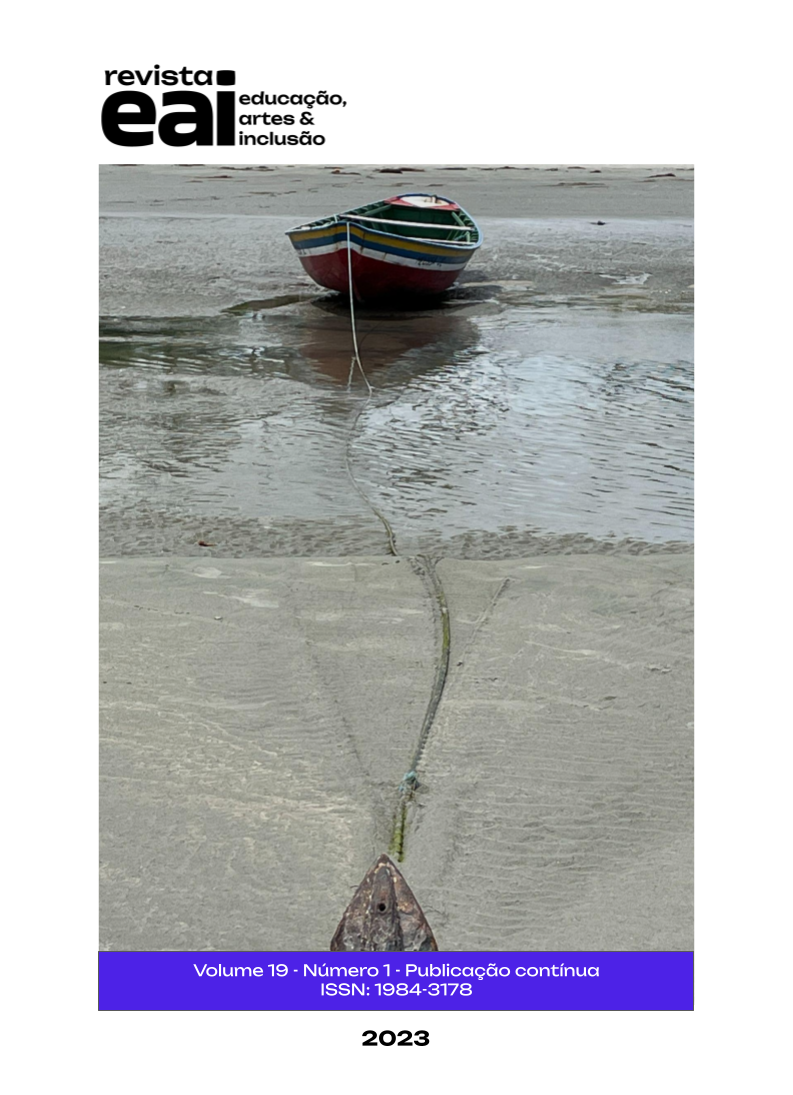Eco-friendly printmaking and its contributions to basic education
DOI:
https://doi.org/10.5965/198431781820231e0046Keywords:
eco-friendly printmaking, printmaking techniques, printmaking in basic education IAbstract
Printmaking, like traditional visual expressions, has expanded its technical and conceptual repertoire as a result of experiments and investigations carried out in the last fifty years (MORO, 2017). Throughout this text, it intends to show that Ecological Printmaking (EP), a product of this expansion, has influenced the emergence of new procedures introduced in Basic Education I, contributing to the development of a sensitive perception and an ethical conscience and conduct of students, in their relationship with the environment. Seeks to identify in these process of choosing disposable materials, the creative management in the making of matrices, highlighting how the concept of sustainability is applied in school artistic practices. (AGUILAR MORENO, 2017) and its progress as a training tool for citizenship. Finally, based on these contributions, highlights the effective relation of EP with the skills required by the new curricular standards known as the Common Core State Standards (BNCC in the Portuguese acronym), including experimenting with different forms of artistic expression, making sustainable use of conventional and unconventional materials, instruments, resources and techniques. (BNCC, 2017).
Downloads
References
AGUILAR MORENO, Marta. Grabado sostenible. Experiencias y prácticas de mediación educativa en Primaria. Universidade Complutense de Madri. n.18, set. 2017.
BARBOSA, Ana Mae. Imagem no ensino da arte: anos 80 e novos tempos. São Paulo: Perspectiva, 1991.
BERNAL, María del Mar. Técnicasdegrabado.es: difusión virtual de la gráfica impresa). Cuadernos de Bellas Artes, v. 14. La Laguna (ES): Sociedad Latina de Comunicación Social, 2013. Disponível em: https://www.academia.edu/attachments/ 46171461/download_file?st=MTY0NTU0OTA2MywxODYuMjE0LjE3OS43Mw%3D%3D&s=swp-splash-paper-cover Acesso em: 02 maio 2021.
BNCC. Arte. Arte no Ensino Fundamental – Anos Iniciais. In: Base Nacional Comum Curricular. 2017. Disponível em: http://basenacionalcomum.mec.gov. br/images/BN CC_EI _EF_110518_versaofinal_site.pdf. Acesso em: 10 maio 2021.
BRASIL. Ministério da Educação. Base Nacional Comum Curricular. MEC, 2017. Brasília, DF, 2017. Disponível em: http://basenacionalcomum.mec.gov.br/images/ BNCC_EI_EF_110518_versaofinal_site.pdf Acesso em: 12 fev. 2022.
BROUGÈRE, Gilles. A criança e a cultura lúdica. In: KISHIMOTO, T. M. O brincar e suas teorias. São Paulo: Pioneira Thomson Learning, 2002.
CLARK, A.; CHALMERS, D. La mente extendida. Oviedo: KRK, 2011.
JAPIASSÚ, Carlos Eduardo; GUERRA, Isabella F. 30 anos do Relatório Brundtland: nosso futuro comum e o desenvolvimento sustentável como diretriz constitucional brasileira. Revista de Direito da Cidade, [S.l.], v. 9, n. 4, p. 1884-1901, out. 2017. Disponível em: https://www.e-publicacoes.uerj.br/index.php/rdc/article/view/30287/ 23 220. Acesso em: 20 jun. 2021.
MARTÍNEZ MORO, Juan. Grabado en expansión: medios históricos nuevas perspectivas. Cátedra de Dibujo de la Universidad de Cantabria, 2017.
OSÓRIO, Luiz Camillo. Da pintura e do sagrado – a contradança da ternura. In: Paulo Sérgio Duarte (org.). Carlos Vergara – pinturas. Rio de Janeiro: Automática, 2011.
PAPALIA, Diane; FELDMAN, Ruth. Desenvolvimento humano. Tradução Carla Filomena M. P. Vercesi [et al.]. 12ª. ed. Porto Alegre: AMGH, 2013.
V.V.A.A. Report of the world commission on environment and development: Our Common Future. Disponível em: https:/sustainabledevelop ment.un.org/content/docu ments/5987our-common-future.pdf Acesso em: 17 jun 2021.
Downloads
Published
How to Cite
Issue
Section
License
Copyright (c) 2023 Isabel Catarina Suzart Argolo

This work is licensed under a Creative Commons Attribution-NonCommercial 4.0 International License.
Copyright Statement
The Educação, Artes e Inclusão is a journal that follows the Free Access Policy. The articles published by the journal are free of charge, intended for educational and non-commercial applications. The articles whose authors are identified represent the expression from the point of view of their authors and not the official position of the Educação, Artes e Inclusão Journal or the Educação, Artes e Inclusão Research Group.
Authors who publish in this journal agree to the following terms:
(A) Authors retain the copyright and grant the journal the right of first publication, with the work simultaneously licensed under the Creative Commons Attribution License which allows the sharing of the work with acknowledgment of authorship and initial publication in this magazine.
(B) Authors are authorized to take additional contracts separately, for non-exclusive distribution of the version of the work published in this journal (eg publish in institutional repository or as a book chapter), with acknowledgment of authorship and initial publication in this magazine.
(C) This journal provides public access to all of its content, as this allows for greater visibility and scope of published articles and reviews. For more information on this approach, visit the Public Knowledge Project.
This journal is licensed under a Creative Commons Attribution-NonCommercial-ShareAlike 4.0 International License. This license allows others to remix, adapt and create from your work for non-commercial purposes, and although new work must give you due credit and cannot be used for business purposes, users do not have to license such derivative works under the same terms.



